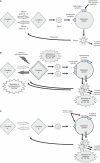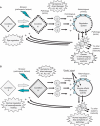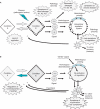Immunology and homeopathy. 5. The rationale of the 'Simile'
- PMID: 17549232
- PMCID: PMC1876612
- DOI: 10.1093/ecam/nel117
Immunology and homeopathy. 5. The rationale of the 'Simile'
Abstract
The foundation of homeopathic medicine is the 'Similia Principle', also known as the 'Principle of Similarity' or also as the 'Simile', which reflects the inversion of pharmacological effects in healthy subjects as compared with sick ones. This article describes the inversion of effects, a widespread medical phenomenon, through three possible mechanisms: non-linearity of dose-response relationship, different initial pathophysiological states of the organism, and pharmacodynamics of body response to the medicine. Based on the systemic networks which play an important role in response to stress, a unitary and general model is designed: homeopathic medicines could interact with sensitive (primed) regulation systems through complex information, which simulate the disorders of natural disease. Reorganization of regulation systems, through a coherent response to the medicine, could pave the way to the healing of the cellular, tissue and neuro-immuno-endocrine homeodynamics. Preliminary evidence is suggesting that even ultra-low doses and high-dilutions of drugs may incorporate structural or frequency information and interact with chaotic dynamics and physical-electromagnetic levels of regulation. From the clinical standpoint, the 'simile' can be regarded as a heuristic principle, according to which the detailed knowledge of pathogenic effects of drugs, associated with careful analysis of signs and symptoms of the ill subject, could assist in identifying homeopathic remedies with high grade of specificity for the individual case.
Figures



 inhibition.
inhibition.



References
-
- Hahnemann CFS. Versuch über ein neues Princip zur Auffindung der Heilkrafte der Arzneisubstanzen (Essay on a new principle for ascertaining the curative powers of drugs) Hufeland's J. 1796;2:391–439.
-
- Boyd LJ. A Study of the Simile in Medicine. Philadelphia: Boericke and Tafel; 1936.
LinkOut - more resources
Full Text Sources

